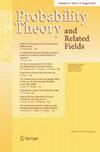关于维纳香肠空位集和布朗交错的唯一性问题
IF 1.6
1区 数学
Q2 STATISTICS & PROBABILITY
引用次数: 0
摘要
我们考虑的是(随机)维度 \(d \ge 3\) 中 \({\mathbb {R}}^d\) 的维纳香肠(随机)集合的空闲集的连通性。我们证明布朗交错的空集几乎肯定包含最多一个无限连通分量。对于有限的维纳香肠集合,我们提供了关于其空闲集在微观球中至少包含两个连通分量的概率的尖锐多项式边界。主要证明成分是几个布朗运动在避开一个稍小的球的同时共同访问单位球的所有半球的概率的尖锐多项式约束。本文章由计算机程序翻译,如有差异,请以英文原文为准。

On questions of uniqueness for the vacant set of Wiener sausages and Brownian interlacements
We consider connectivity properties of the vacant set of (random) ensembles of Wiener sausages in \({\mathbb {R}}^d\) in the transient dimensions \(d \ge 3\). We prove that the vacant set of Brownian interlacements contains at most one infinite connected component almost surely. For finite ensembles of Wiener sausages, we provide sharp polynomial bounds on the probability that their vacant set contains at least 2 connected components in microscopic balls. The main proof ingredient is a sharp polynomial bound on the probability that several Brownian motions visit jointly all hemiballs of the unit ball while avoiding a slightly smaller ball.
求助全文
通过发布文献求助,成功后即可免费获取论文全文。
去求助
来源期刊

Probability Theory and Related Fields
数学-统计学与概率论
CiteScore
3.70
自引率
5.00%
发文量
71
审稿时长
6-12 weeks
期刊介绍:
Probability Theory and Related Fields publishes research papers in modern probability theory and its various fields of application. Thus, subjects of interest include: mathematical statistical physics, mathematical statistics, mathematical biology, theoretical computer science, and applications of probability theory to other areas of mathematics such as combinatorics, analysis, ergodic theory and geometry. Survey papers on emerging areas of importance may be considered for publication. The main languages of publication are English, French and German.
 求助内容:
求助内容: 应助结果提醒方式:
应助结果提醒方式:


